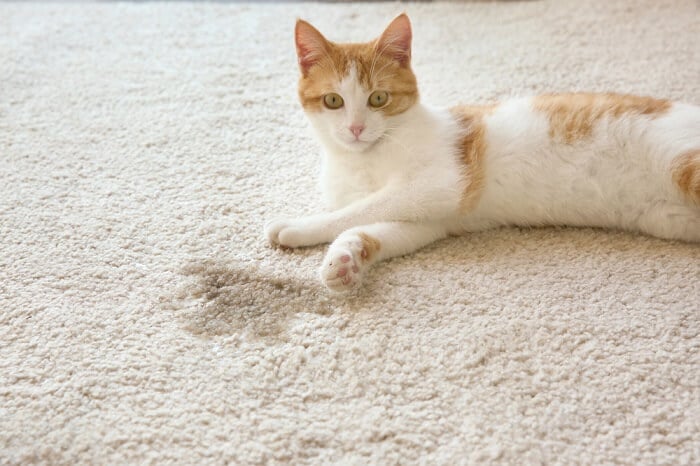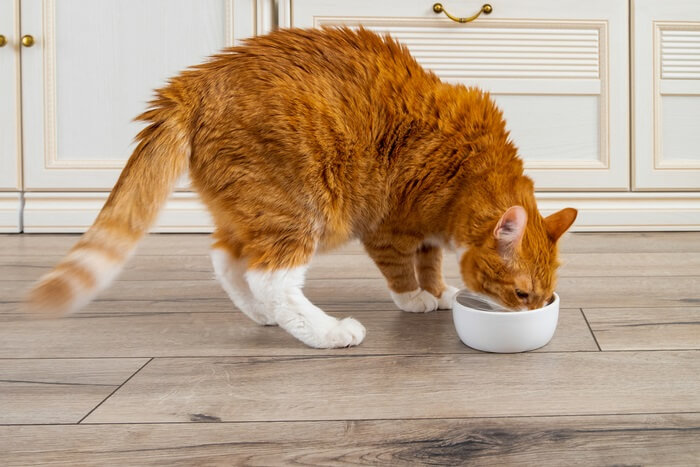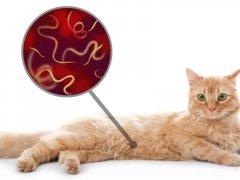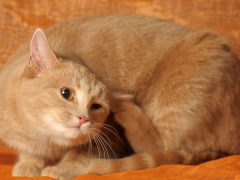
Bladder stones in cats are a generally less common but no less concerning cause of urinary issues and a potentially life-threatening cause of urinary tract obstruction. In this article, you will learn what bladder stones are, the two most common types of stones, and how these are diagnosed, treated, and prevented.
What Are Bladder Stones in Cats?
A bladder stone is essentially a hard rock of crystalline mineral, often roughly spherical or oval in shape, that can form in the bladder of a cat. People, dogs, and other animals can get bladder stones too.
When one or more bladder stones form, they sometimes cause irritation of the bladder wall, leading to signs of frequent urinating, urinary straining, inappropriate urination in the house, and blood in the urine. However, sometimes a kitty may have no noticeable signs at all.
The signs that may accompany bladder stones in cats are not exclusive. They can also be seen with urinary tract infections, a condition called idiopathic cystitis, and even behavioral causes.
These conditions that share these symptoms are grouped into a syndrome called feline lower urinary tract disease (FLUTD).
The biggest risk of a cat having one or more bladder stones is that they can cause a life-threatening blockage of the urinary tract.
Because a cat who develops signs of frequent urination, straining, or blood in the urine could be afflicted with any of the conditions under the umbrella of FLUTD, and a risk of a life-threatening urethral obstruction is always a possibility, any kitty developing these signs should be examined by a veterinarian as soon as possible.
If a kitty is ever seen to strain or attempt to urinate with no production of urine, and especially if he or she develops other signs like lethargy, vomiting, or poor appetite, this should be considered an emergency requiring immediate veterinary care.
Causes of Bladder Stones in Cats

There are several types of stones that may form in a cat’s bladder, and these may form for a variety of reasons.
While there are at least four types of bladder stones a cat could develop, a majority of cases are caused by only two types. One is called magnesium ammonium phosphate, or struvite. The other is called calcium oxalate. They can both have different causes.
Struvite stones are the most common type of bladder stone in cats.
These stones form in alkaline (non-acidic) urine and do tend to affect younger cats less than 7 years of age more often. There has been an established link with kitties eating diets higher in magnesium and phosphorous. While these stones do widely affect all cats, a couple of breeds including the Ragdoll may be at higher risk. Male cats, and especially neutered male cats are also considered to be at higher risk.
Calcium oxalate stones are a little different.
They more often affect older cats greater than 7 years of age and only form in more acidic urine. The Ragdoll is once again a higher-risk breed, along with a few others. Like struvite stones, diet can be related to calcium oxalate stone formation, especially if there is excessive calcium supplementation or if a diet contributes to the urine being too acidic.
About a quarter of cats with calcium oxalate stones do have high levels of calcium in their bloodstream. In most cases in kitties, this is caused by idiopathic hypercalcemia, a condition that is poorly understood, but fortunately is treatable in most cases.
Unlike struvite stones in dogs, which are often associated with urinary tract infections, neither stone type in cats has an association with UTI’s.
How Do Bladder Stones Form in Cats?
Regardless of stone type, the formation process is very similar. If too many of these minerals come out of solution in the urine, they collect as a sandy silt at the bottom of the bladder. This causes irritation of the urinary bladder wall, which leads to mucus being secreted in response. The sandy/silty crystalline particles mix with mucus particles and over time enlarge into stones.
As an example, think of a glass of water that you then add some salt to. If you add just a small amount, the salt will dissolve in the water. But if you continue to add salt the mixture will become oversaturated, and you’ll see salt start to collect at the bottom of your glass. This is similar to what initially happens in a kitty’s bladder.
Treatment for Bladder Stones in Cats
As mentioned earlier, any kitty showing signs of abnormal urinary behavior should be examined by a vet to determine which of the several possible causes is responsible. This commonly first involves having a urine sample collected and evaluated.
With calcium oxalate stones, the urine pH will be acidic. With struvite stones, a cat’s urine pH will be alkaline (non-acidic). When urine is examined under a microscope, it is possible that calcium oxalate or struvite crystals will be identified, though this is not always the case. Urinary crystals may be present without stones, and stones may be present without urinary crystals.
The results of a urinalysis may prompt a vet to evaluate the bladder for stones using either radiographs (x-rays) or ultrasound. With x-rays, bladder stones will appear as bright white objects. With an ultrasound, stones will block sound waves from going past them, leading to a characteristic black shadow obscuring the bottom of the bladder.
When bladder stones are identified, there are a couple of treatment options, each having advantages and disadvantages.
Bladder stones are uncomfortable for kitties and do present a risk for urinary tract obstruction, especially in male cats, so they should be removed as soon as possible. The quickest way to do this is with surgery, which is called a cystotomy. Many general practice vets perform this procedure, and a majority of kitties recover very well.
The second primary treatment method is to attempt to dissolve the stones using a prescription diet designed for that purpose. While this can also be successful, there are some drawbacks.
First, only struvite stones can be dissolved with a diet. Calcium oxalate stones cannot, and must be removed by surgical means. Since there is no 100% reliable way to know what type of stone is present beforehand, there is roughly a 50/50 chance of a dissolution diet being successful.
The second drawback to a diet is that it does typically take several weeks to work, sometimes at least 2 months. During this time, a kitty may continue to exhibit signs of inappropriate urination, and the risk of urinary obstruction is a constant concern.
In female cats, it may be possible to flush the bladder with a special technique called voiding urohydropropulsion to get the stones out. However, like bladder surgery, this method also requires anesthesia and can only be used for very small stones. Since even tiny stones can get lodged in a male cat’s urethra, this method is not typically performed in male cats.
How To Prevent Bladder Stones?

The most reliable way to prevent bladder stones is by feeding your cat a prescription diet.
The most reliable method to prevent bladder stones in cats is to keep a kitty on a prescription diet specific for that purpose. These diets are typically lower in magnesium and phosphorus, and are designed to keep the urine pH neutral. Both calcium oxalate and struvite stones can be prevented with a prescription diet.
For a prescription diet to work, it has to be eaten exclusively. With a couple exceptions, these diets are well-balanced and can also be fed to other cats in the home long term.
In situations where a prescription diet may not be affordable, or a picky eater at home defeats the purpose, the goal would be to at least increase the moisture of food and water intake to keep the urine more dilute.
This can be achieved by increasing the percentage of wet food in the diet, adding water to dry food, and encouraging more water intake with multiple water bowls and running water sources, like a kitty water fountain. Unfortunately, these methods alone are not as successful, and recurrence of stones can occur.
Also Read: How To Train a Cat To Use a Water Fountain
Much less commonly, an underlying disorder may also be present that needs to be treated to prevent stones from forming. An example would include idiopathic hypercalcemia in cats contributing to calcium oxalate stone formation.
Also Read: Best Cat Food for Urinary Tract Health
Conclusion
While typically less common than some other urinary abnormalities like urinary tract infections and idiopathic cystitis, bladder stones in cats can still be a concerning cause of urinary tract disease and a risk for urinary obstruction.
Anytime a kitty demonstrates signs of frequent urination, inappropriate urination, or urinary straining at home, it’s very important to have the problem assessed by a vet as soon as possible. And remember, if a kitty appears to be trying to urinate without producing any urine, this should be considered an emergency that requires immediate veterinary attention.







